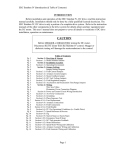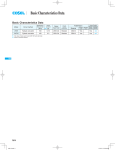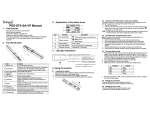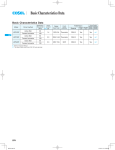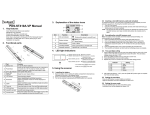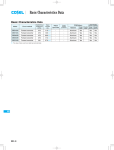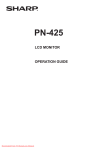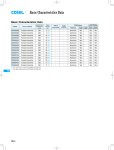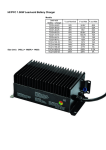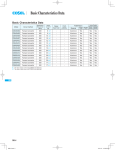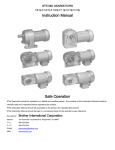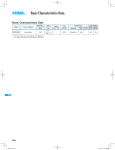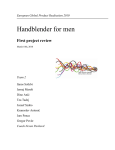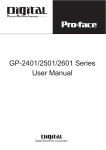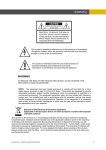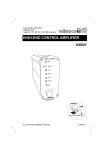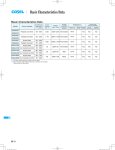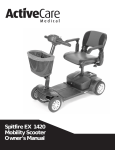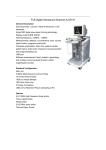Download Basic characteristics data • Instruction manual
Transcript
Basic Characteristics Data R Basic Characteristics Data Material Single sided Series/Parallel operation availability Double Series Parallel sided operation operation Resistor CEM-3 Yes Yes*1 *1 125V 2A Thermistor CEM-3 Yes Yes *1 125V 3A Thermistor CEM-3 Yes Yes *1 Model Circuit method Switching frequency [kHz] Input current [A] Rated input fuse Inrush current protection R10A Flyback converter 80 - 350 0.3 125V 2A R15A Flyback converter 60 - 340 0.36 R25A Flyback converter 70 - 290 0.6 PCB/Pattern R50A Forward converter 200 1.1 125V 3A Thermistor CEM-3 Yes Yes *1 R100U Forward converter 160 2.8 125V 5A SCR CEM-3 Yes Yes *1 R150U Forward converter 160 4.2 125V 6.3A SCR CEM-3 Yes Yes *1 *1 Refer to Instruction Manual. * Switching frequecy of flyback converter depends on input voltage and load factor. * The value of input current is at ACIN 100V and rated load. R-14 AC-DC Power Supplies Enclosed type Instruction Manual R 1 Terminal Block R-16 2 Function R-17 2.1 Input voltage range R-17 2.2 Inrush current limiting R-17 2.3 Overcurrent protection R-17 2.4 Overvoltage protection R-17 2.5 Output voltage adjustment range R-17 2.6 Remote sensing R-18 2.7 Isolation R-18 3 Series Operation and Parallel Operation R-18 4 Assembling and Installation Method R-19 4.1 Installation method R-19 4.2 Derating R-19 4.3 Mounting screw R-19 R-15 AC-DC Power Supplies Enclosed type R 1 Terminal Block Instruction Manual lR50A lR10A +Output -Output Frame ground AC(L) AC(N) LED Output voltage adjustable potentiometer +Output -Output Frame ground AC(L) AC(N) LED Output voltage adjustable potentiometer lR100U lR15A +Output -Output Frame ground AC(L) AC(N) LED Output voltage adjustable potentiometer +Remote sensing(+S) +V Output -V Output -Remote sensing(-S) Frame ground AC(L) AC(N) LED Output voltage adjustable potentiometer lR150U lR25A +Output -Output Frame ground AC(L) AC(N) R-16 LED Output voltage adjustable potentiometer +V Output -V Output Frame ground AC(L) AC(N) LED Output voltage adjustable potentiometer +Remote sensing(+S) -Remote sensing(-S) AC-DC Power Supplies Enclosed type Instruction Manual R 2 Function 2.1 Input voltage range nThe range is from AC85V to AC132V or DC110V to DC170V. nAC input voltage must have a range from AC85V to AC132V for normal operation. If the wrong input is applied, the unit will not operate properly and/or may be damaged. nIn cases that conform with safety standard, input voltage range is AC100-AC120V(50/60Hz). : Load characteristics of power supply. : Characteristics of load (lamp, motor, constant current load, etc.). Note: In case of nonlinear load, the output is locked out at A point. Fig. 2.1 Current foldback characteristics 2.2 Inrush current limiting nInrush current limiting is built-in. nIf a switch on the input side is installed, it has to be the one han- 2.4 Overvoltage protection lR10A R15A dling the input inrush current. nOvervoltage protection circuit, clamping the output voltage by lR15A R25A R50A zener diode, is built-in and comes into effect at over 115% of the nThe thermistor is used for protection from inrush current. When rated voltage. (For 3V type, overvoltage protection kicks in at power is turned ON/OFF repeatedly within a short period of time, over 4V.) The unit in an overvoltage protection mode cannot be re- it is necessary to have enough time for power supply to cool covered by a user; it must be repaired at the factory. Overvoltage down. protection (diode) also comes into effect if the voltage is externally applied to the output side. Avoid applying voltage to the output side. lR100U R150U nThe thyristor technique is used for protection from inrush current. When power is turned ON/OFF repeatedly within a short period of lR25A R50A R100U R150U time, it is necessary to have enough time between power ON and nThe overvoltage protection circuit is built-in and comes into effect OFF to operate resistance circuit for inrush current. at 115 - 140% of the rated voltage. The AC input should be shut down if overvoltage protection is in operation. The minimum inter- No. 1 2 3 Model R10A R15A R25A Table 2.1 Inrush current Model Inrush current No. R50A 4 20 R100U 5 20 R150U 6 20 Unit:[Atyp] Inrush current 30 15 15 val of AC recycling for recovery is 2 to 3 minutes. The recovery time varies depending on input voltage. Remarks: Please avoid applying the over-rated voltage to the output terminal. Power supply may operate incorrectly or fail.In case of oper- 2.3 Overcurrent protection nOvercurrent protection is built-in and comes into effect at over 105% of the rated current. Overcurrent protection prevents the ating a motor etc. , please install an external diode on the output terminal to protect the unit. unit from short circuit and overcurrent condition. The unit auto- 2.5 Output voltage adjustment range matically recovers when the fault condition is cleared. nAdjustment of output voltage is possible by using potentiometer. nOutput voltage is increased by turning potentiometer clockwise lR10A R15A R25A and is decreased by turning potentiometer counterclockwise. nThe power supply which has a current foldback characteristics may not start up when connected to nonlinear load such as lamp, motor or constant current load. See the characteristics below. R-17 AC-DC Power Supplies Enclosed type Instruction Manual R 2.6 Remote sensing lR100U R150U (1) When not using remote sensing function 3 Series Operation and Parallel Operation lR100U nSeries operation is available by connecting the outputs of two or more power supplies, as shown below. Output current in series connection should be lower than the lowest rated current in each unit. lR15A - R150U lR150U (2) When using remote sensing function When the output voltage is less than 5V. D1 Power supply + Power supply + D2 - Load lR100U lR10A lR150U D3 - D4 D1 - D4: Please use Schottky Barrier Diode. When the output voltage is more than 12V. nWhen not using this function, confirm that terminals are shorted Power supply + Power supply + - Load between +S and +V, and between -S and -V with short pieces. nWhen using this function, wiring should be done without short pieces. nDevices inside the power supply might be damaged when poor - connection on load lines occurs, e.g. because of loose connector screws. nThick wire should be used for wiring between power supply and load, and line voltage drop should be less than 0.3V. nWhen long sensing wire is required, use C1, C2 and C3. nParallel operation is not possible. nRedundancy operation is available by wiring as shown below. nTwisted-pair wire or shield wire should be used for sensing wire. Power supply + (decrease) the voltage for the start (shut down). Avoid using HiPot tester with the timer because it may generate voltage a few times higher than the applied voltage, at ON/OFF of a timer. R-18 I3 - 2.7 Isolation nFor a receiving inspection, such as Hi-Pot test, gradually increase I1 Load nPlease do not draw output current from +S, -S terminal. Power supply + - I2 Instruction Manual AC-DC Power Supplies Enclosed type nEven a slight difference in output voltage can affect the balance Load factor [%] between the values of I1 and I2. Please make sure that the value of I3 does not exceed the rated current of a power supply. I3 80 60 20 0 R10A 4.1 Installation method nWhen two or more power supplies are used side by side, position them with proper intervals to allow enough air ventilation. Ambient temperature around each power supply should not exceed the tem- Convection Forced air (0.5m3/min) 40 the rated current value 4 Assembling and Installation Method R 100 R15A R25A R50A A mounting -10 B mounting C, D mounting 0 10 20 30 [20] 40 [30] 50 [40] 60 [50] 70 [60] 40 [30] 50 [40] 60 [50] 70 [60] 60 [55] 30 [25] 40 [35] 50 [45] 40 [30] 50 [40] 60 [50] 70 [60] 40 [30] 50 [40] 60 [50] 70 [60] 30 [25] 40 [35] 50 [45] 60 [55] A mounting B mounting C, D mounting 40 [30] 50 [40] 60 [50] 70 [60] 40 [30] 50 [40] 60 [50] 70 [60] 30 [20] 40 [30] 50 [40] 60 [50] A mounting B mounting C, D mounting 40 [30] 50 [40] 60 [50] 70 [60] 40 [20] 50 [30] 60 [40] 70 [50] 30 [20] 40 [30] 50 [40] 60 [50] A mounting 40 [30] 50 [40] 60 [50] 70 [60] 30 [20] 40 [30] 50 [40] 60 [50] 30 [20] 40 [30] 50 [40] 60 [50] A mounting B mounting C, D mounting R100U B mounting R150U C, D mounting Ambient temperature [ ] perature range shown in derating curve. Inside [ ] is with case cover Note: 4.2 Derating In the hatched area, the specification of Ripple, Ripple Noise is def- nThe operative ambient temperature is different by with/without erent from other area. case cover or mounting position. Please refer drawings as below. nWhen unit mounted except below drawings, it is required to con- sider ventilated environment by forced air cooling for temperature/load derating. For details, please consult our sales or engi- 4.3 Mounting screw nKeep isolation distance between screw and internal components as below chart. neering departments. Unit:[mm] Model max Model max R10A 6 R50A 6 R15A 6 R100U 8 R25A 6 R150U 8 R-19






